Photo


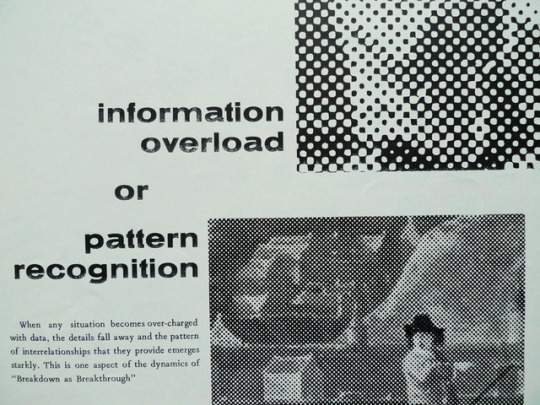



Marshall McLuhan (CA, 1911–1980)
Marshall McLuhan had already noted in the 1960s that the speed and pervasiveness of electronic communication was superseding the rational and reflective abilities of literacy. The technologies that brought us here are built through rational disinterested scientific method, but generate an immersive environment where we lose grasp of private identity and long for a pre-literate togetherness in a ‘Global Village’. His ‘Global Village’ came to exemplify the uncritical Summer of Love communality of the Hippies, but it was a misappropriation and misunderstanding of McLuhan’s meaning. For McLuhan the ‘Global Village’ was a place of violent terror, where there was constant surveillance and where privacy was ‘merely ignored’, as he frankly describes in a famous interview with Canadian talk show host Mike McManus.
McLuhan rose to prominence as perhaps the most famous cultural critic of his age with an analysis that directly engaged with the transformations emerging with the introduction of electronic technologies. His involvement was gestural, reason alone would not suffice to grapple with the contemporary conditions, there was a techno-cultural revolution afoot, which was completely disrupting how human beings had perceived the world for hundreds of years.
1 note
·
View note
Photo

MRZB (IT)
MRZB is a collective of young Italian artists (Andrea Parenti, Désirée De Monte, Filippo Tocchi, Giorgio Tidoni and Pietro Cortona) who open up the emptiness behind the digital communication surfaces. They reach into casual Net culture, messageboards, forums and shopping sites as a performing poly-persona. They elaborate how to build an identity online.
1 note
·
View note
Video
youtube
Thomas Bégin (CA, 1979) - Synthétiseurs
strings, speakers, guitars, amplifiers
2014
0 notes
Photo



Angela Washko (US, 1986) - The Game: The Game
video game, immersive installation and platform
2016
‘The Game: The Game’ is an immersive installation and platform to experience the first chapter of a video game presenting the practices of several prominent seduction coaches (aka pick-up artists) through the format of a dating simulator. In the game these pick-up gurus attempt to seduce the player using their signature techniques taken verbatim from their instructional books and video materials.
Players explore the complexity of the construction of social behaviors around dating as well as the experience of being a woman navigating this complicated terrain. The video game is presented alongside the video and print-based source materials from the seduction coaches themselves as well as handmade cyanotype prints, videos and books produced by the artist in response to her experience investigating this field and the ways in which women are literally presented as objects in physical and digital space.
‘The Game: The Game’ is a continuation of ‘BANGED’ a year-long project in which the artist interviewed ‘Bang’ series author/manosphere figurehead and tried to get in contact with his alleged sexual partners. After working on ‘BANGED’, the black and white ways in which this field has been portrayed seemed too simple and unfair to all parties who encounter it and provoked this question: Is practicing “game” inherently wrong and dishonest or can it be practiced in a way that simply levels the dating playing field in favor of those who are otherwise socially or physically disadvantaged?
By disguising the most notorious PUAs alongside game-less individuals and PUAs-in-training and placing the player into the perspective of a woman forced to distinguish between them all – Washko hopes to add levels of complexity to public conversations around both pick-up and feminism which have both found themselves most often presented in highly polarized, dichotomous positions in mainstream media.
The first chapter of the game was presented at TRANSFER Gallery in NYC along with a musical score composed by Xiu Xiu, whose perverse, challenging, personal and complex music complement the murky, frequently dark, isolating and complicated experiences and aesthetics presented in ‘The Game: The Game’.
0 notes
Photo

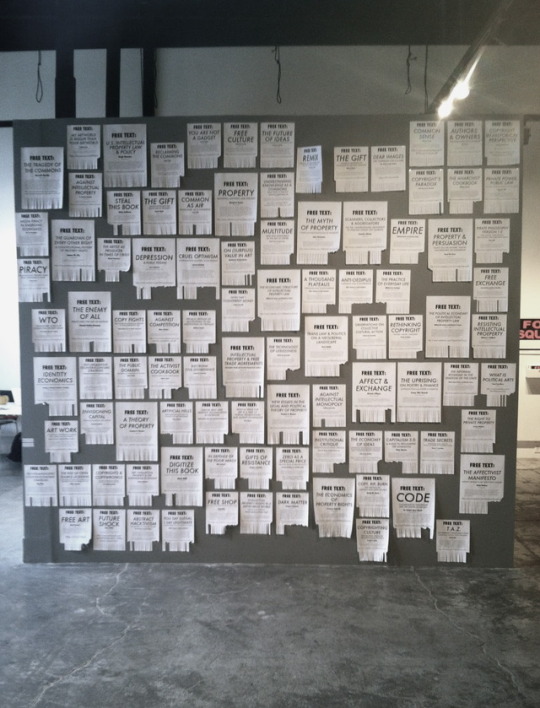
Stephanie Syjuco (PH, 1974) - Free Texts: An Open Source Reading Room
wall of flier take-aways of URLs for free online texts
2013
1 note
·
View note
Video
youtube
Hito Steyerl (DE, 1966) - STRIKE
Full-HD, col.
00:00:35
2010
0 notes
Video
vimeo
Wolfgang Spahn (DE, 1970) - It's Organic If You Look Close Enough
3 OLED Screens, 3 Raspberry Pi with Raspi Cam, amplifier, speaker
2017
The Audio-Video-Installation It's Organic If You Look Close Enough aims at deconstructing the so-called perfect surface that is created within the virtual sphere by contemporary digital technology. By using macrofilming to explore the surface of OLED-monitors the camera visualizes the frayed edges of the Organic Light Emitting Diodes (OLED's). Thus it creates images that would not be visible to the naked eye: the so-called homogeneous perfect squares are indeed uniquely shaped, ragged, and uneven when approached with macro lenses.
0 notes
Photo

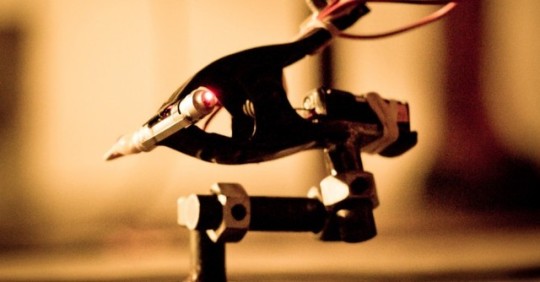
Thomas Bégin (CA, 1979)
Tant dans ses installations que lors de ses performances, l’artiste montréalais Thomas Bégin combine avec brio les objectifs du scientifique qui aspire à la concrétisation de ceux-ci au débordement ludique de l’artiste qui peut s’égarer dans les méandres de la création mais qui, lui aussi, aspire à une finalité exemplaire de l’œuvre. Artiste multidisciplinaire, Thomas Bégin interroge et détourne en les minimisant des principes actifs dans les sciences qu’il étudie avec minutie ; il propose ses propres théorèmes dans des domaines tels que la mécanique et l’optique pour au final développer sa propre cybernétique et son art.
0 notes
Video
vimeo
Reynold Reynolds (US, 1966) - Die Verlorenen
HD video transferred from 16mm
80 min.
2015/1933
with live musical accompaniment by
Gerard Bouwhuis (piano), Heleen Hulst (violin and Foley) and Jellantsje de Vries (viola and Foley)
A film project started in the 1930s, but unfinished.
Newly discovered, remade, completed and performed.
During the year 1933 in Germany film productions were shut down, censorship was imposed, thousands of actors were fired and hundreds of films were destroyed.
Die Verlorenen revives a German film from the 1930s that could have been, but never was.
The film tells the story of a young British writer, Christopher, who comes to Berlin and moves into the Troika, a cabaret where an eccentric old man adopts young performers, artists and musicians. In the basement Christopher bears witness to mystical experiments investigating the boundary between life and death discovering his own identity. Against this backdrop of creative experimentation the cabaret is under threat from growing political conservatism.
The film material was assembled by Reynold Reynolds and is screened with a live musical score arranged and performed by Gerard Bouwhuis (piano), Heleen Hulst (violin) and Jellantsje de Vries (viola). Both Heleen Hulst and Jellantsje de Vries will additionally perform as Foley artists with the film; creating sound effects within the boundaries of the soundscape of the musical score.
The score has been based on musical fragments from the early 1920s and 1930s by composers such as Franz Schreker, George Antheil, Erwin Schulhoff, Stefan Wolpe, Paul Hindemith and Hans Eissler.
0 notes
Video
vimeo
Christof Migone (CA 1964) - On Strike
microphones, kinetic apparatus, board, saw
2015
with Marla Hlady
To strike on various surfaces. The machines automate the hitting that performers usually do with microphones in Hit Parade. One could say that they were built to replace performers in case of strike, but we couldn’t. In Strike and Hit both machines and performers struck on and out together in amongst the Henry Moores at the Art Gallery of Ontario.
0 notes
Photo


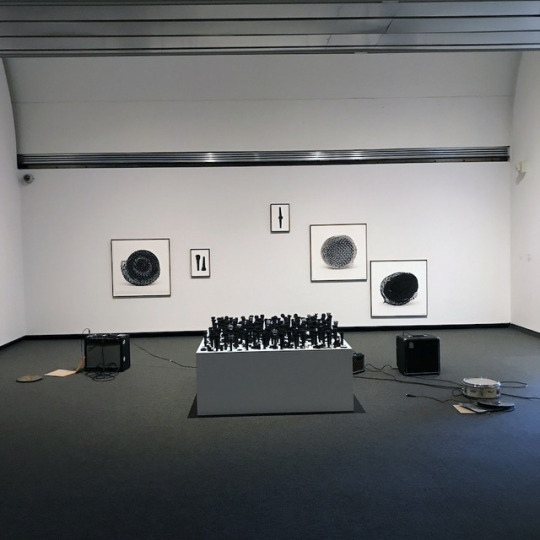
Christof Migone (CA 1964) - Testing, Testing
microphones, amplifiers, speakers
as long as it takes to test all the microphones on display
2017
Does the microphone work?
0 notes
Audio
Christof Migone - Crackers (Halifax) - 1
2016
Digital-only release including re-mastered version of Crackers (Ottawa).
Other version: Crackers (Ottawa).
Commissioned by Tracing the City: Interventions of Art in Public Space for the Urban Encounters: Art and the Public conference, NSCAD University / Dalhousie University, Halifax, October 10-12, 2013.
Participants: Ksenia Azanova, Spencer Davenport, Kylie Dyment, Rose Erin, Laura Hadley, Masaaki Itow, Gillian Maradyn Jowsey, Emily Lawrence, AJ MacDonald, Claire Matthews, Lee Roth, Jessica Lynn Weibe, Sophie Wonfor.
Recorded with the assistance of Annie Onyi Cheung.
Audio mastering by Grey Market Mastering.
0 notes
Photo



!MEDIENGRUPPE BITNIK (DE) - RANDOM DARKNET SHOPPER
automated online shopping bot
2014 - ongoing
The Random Darknet Shopper is an automated online shopping bot which we provide with a budget of $100 in Bitcoins per week. Once a week the bot goes shopping in the deep web where it randomly chooses and purchases one item and has it mailed directly to the exhibition space. Once the items arrive they are unpacked and displayed, each new object adding to a landscape of traded goods from the Darknet.
The Random Darknet Shopper is a live Mail Art piece, an exploration of the deep web via the goods traded there. It directly connects the Darknet with the gallery. By randomizing its consumerism, the bot is guaranteed a wide selection of goods from the thousands listed on deepweb markets.
In its first run from October 2014 - January 2015, Random Darknet Shopper bought 12 items from the deepweb market Agora, which were displayed at Kunst Halle St. Gallen in the exhibition «The Darknet - From Memes to Onionland. An Exploration». Since Agora discontinued its services in September, Random Darknet Shopper will now order items from Alpha Bay, currently the largest deepweb market place.
1 note
·
View note
Photo


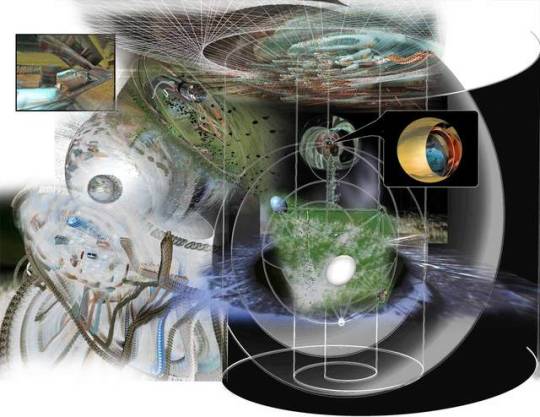
Willy Le Maitre CA, 1966) - Edia
stereo-3d hd video and performed live render
35-40 minutes
2005-2011
0 notes
Video
youtube
Willy Le Maitre (CA, 1966) - Edia: a cosmology of digital space
stereo-3d hd video and performed live render
35-40 minutes
2005-2011
Edia is screen based presentation depicting a cosmology of digital space. The base elements of the screen signal are shown as building blocks for a threshold space that is neither interior or exterior proper. The space is revealed to be creative, infinite and non continuous. Distributed throughout, we see a metaphysics of interior human space as an exploded view of the self. The self no longer confined to an individualist notion.
The work details the notion of a distributed self; distinguishing an individual's body from its counterpart, the dividual. The dividual extends the self into a mesh of relations, communications and emotings. Within Edia's nested structures, a self is shown as a constellation of points distributed around the globe. The points are personified by 'friends' in dialog. The entity's interconnected points on the network form an analogous structure in our own bodies. Edia's molecular constitution is bonded by audiovisual channels that are both its memory and links to the possible in sequences of event. Its amalgamations of inter subjective perspective visualize reality as an artifact of communication.
Video recordings appear as memories of the seen. The spheres are seen from both outside and in. From outside; the video coated spheres are perspective objects that connect with others in ersatz molecular formations. From within; the surface is continuous, providing an immersive enclosure for memory and revery spaces. These spaces evoke the unique worlds of the friends in the artists network of Emotives.
The work describes a new topology of space that the network has produced within us. 3D visualizations are used as optical explorations depicting the abstract concepts of the rhizomatic in networks and databases and their play with the affective structures of human relations . Edia is a digital entity that occupies a 'space' that supports our physical space. Edia is comprised of RGB pixels and computed values that are described and depicted as a cosmology of digital space.
00:00 Edia is enfolded in information space
00:50 it is an entity distributing the self in a constellation of points around the globe. The points are personified by 'friends' in dialog.
01:06 the basic unit of Edia is a spherical point. one begets another. from worlds come worlds, where none is prime.
01:51 all surfaces are covered in video.
02:08 video is bound by pixels: each possesses knowledge of the whole.
02:39 on the surface of the sphere the horizon is continuous.
03:44 the network connects all points.
03:51 our network makes us all visible to one another -- with horizon collapsed, we live inside.
04:20 within the point, space is imagined as occupying the center -- the perspective of the network.
05:29 the point emerges from an ellipse into a cylindrical passage. A network byway that connects hole to whole.
06:30 perspective is established by the eye.
07:20 The eye acts as both witness and writer, encoding the seen into memories that are seeded into the cloud below it.
08:10 Edia is comprised of a network of emotives. The network has a molecular quality, its bonds of audiovisual sequences play in the emotives nodes.
11:11 shells envelope one another, each, a dimension that influences the direction taken at the center.
11:40 at the center: direction of thought is decided. It is the result of a complex interaction of memory, desire and the emotivational.
13:01 Possibles and Incompossibles: forces of perception and imagination are stimulated. The actual materializes, overwriting the cascades of incompossibles.
14:40 while an individual is situated in a single body, its counterpart, the dividual, is distributed to multiple bodies through communication, emotings and associations.
16:04 frequency's value produces character that is attributed to matter
19:04 the Surrounds constitute an ambient system of influencing. An ecliptic of institutions in orbit around us, a cycling of effects. Each of us its subject and each subject to one another.
20:45 the Surrounds boundary is a shell, beyond which, the appearances of pasts and futures, take the shape of here and now.
0 notes
Photo
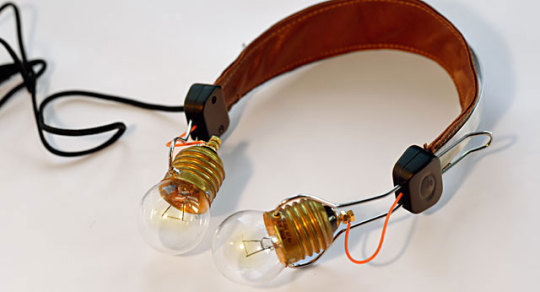
Mogens Jacobsen (DK, 1959) - Lyshør / Listnerlight
headphone, light bulbs
2013
Listnerlight is a detector and eccentric converter of signals. A circuit senses electronic statics from domestic appliances, human bodies, mobilephones, wi-fi networks and converts these to modulated light in incandescent lamp bulbs. The light bulbs are worn as headphones and the vibrations of the filaments can be heard as sounds.
0 notes
Video
vimeo
Darsha Hewitt (CA,1982) - Feedback Babies
Fisher-Price Nursery Monitors, strings, electric motors
2013
The Fisher-Price Nursery Monitor (circa 1983) was a low watt household radio set originally intended to “let parents be in two places at once” by broadcasting the cries of a baby in distress to a mobile receiver accompanying a parent outside of earshot. However, when in very close proximity these devices produce audible feedback that sounds uncannily like whimpering electronic babies. Feedback Babies is an electromechanical sound apparatus that makes use of slow moving motors to automate these transmitters in order to create nuanced feedback patterns.
0 notes